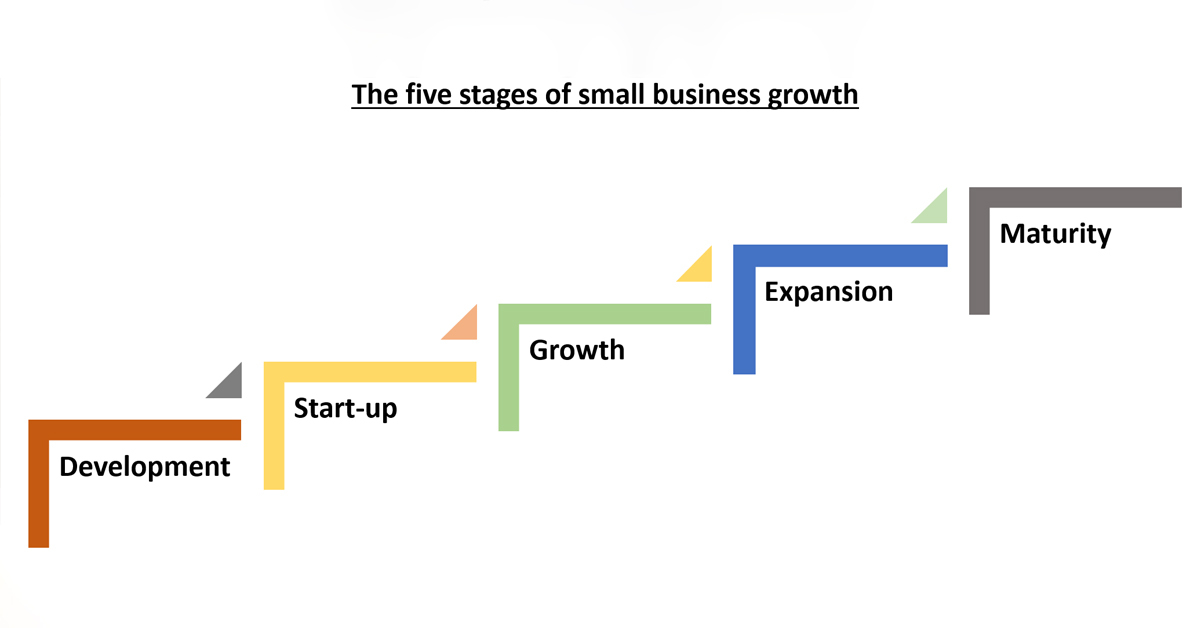The Five Stages of Small Business Growth
Small businesses play a pivotal role in economic development, fostering innovation and creating job opportunities. The journey of a small business is marked by distinct stages of growth, each presenting unique challenges and opportunities. From the initial spark of an idea to establishing market leadership, entrepreneurs must navigate these stages strategically to achieve sustainable success. In this article, we delve into “The Five Stages of Small Business Growth,” offering insights into each phase’s characteristics, hurdles, and effective strategies. Understanding and mastering these stages can empower entrepreneurs to build resilient, thriving businesses in today’s dynamic marketplace.
Stage 1:Laying the Groundwork:
The seed stage involves defining objectives and crafting a robust strategy. Entrepreneurs identify their target market and allocate resources, forming the foundation for their business plan.
Stage 2:Embarking :
The business enters the initial phase with momentum. Entrepreneurs focus on building brands and expanding market share to attract clients. Challenges include balancing growth with limited resources, refining products through customer feedback, and establishing efficient operational processes. Effective customer relationship management and strategic marketing are crucial.
Stage 3: Expanding Horizons in Growth:
During this phase, the business experiences a surge in demand, revenue, and opportunities. Scaling up requires strategic decision-making. Entrepreneurs may explore product expansion, entering new markets, or enhancing distribution. Managing complexity, maintaining quality, and preserving integrity are paramount.
Stage 4: Reaching Heights in Expansion:
Progressing to the expansion stage, the emphasis is on boosting productivity and profitability. Entrepreneurs may consider franchising, diversification, or mergers. Upholding core values across units and balancing centralized oversight with decentralization is vital.
Stage 5:Ensuring Maturity:
The maturity stage signifies market leadership. Maintaining relevance and competitiveness is crucial as growth stabilizes. Prioritizing innovation, allocating resources for advancement, and adapting to trends are vital. Succession planning ensures smooth leadership transition and brand identity preservation.
Plan for Transition:
Succession planning is essential, especially as your business reaches the maturity stage. Identify potential successors and provide them with the necessary training and mentoring. This ensures a seamless leadership transition, preventing disruptions to your business operations.
Market Awareness:
Stay attuned to industry trends, market shifts, and emerging technologies. Regularly update your business strategies to capitalize on new opportunities and adapt to changing customer preferences. Staying ahead of trends keeps your business relevant and competitive.
Maintain Core Values:
As your business evolves, hold to your core values and mission. Communicate these values consistently to employees, customers, and stakeholders. A strong alignment with core values fosters a cohesive company culture and reinforces your brand identity.
Celebrate Achievements:
Recognize and celebrate milestones, both big and small. Acknowledging achievements boosts morale among your team, reinforces a sense of accomplishment, and creates a positive work environment. Celebrations also promote teamwork and camaraderie.
Build Strategic Partnerships:
Collaborate with other businesses, suppliers, or organizations that complement your offerings. Strategic partnerships can help you access new markets, share resources, and leverage expertise, accelerating your growth trajectory.
Invest in Employee Development:
Your team’s growth contributes to the overall growth of your business. Provide opportunities for skill development, training, and career advancement. A skilled and motivated workforce is better equipped to handle increased demands during growth phases.
Monitor and Adapt:
Regularly assess your progress against your goals and adjust your strategies accordingly. Be open to pivoting or refining your approach based on feedback, changing circumstances, and new insights.
FAQs
Q1.What phases of small business development are there?
A1.The introduction phase, the beginning stage, the growth stage, the period of development, and the stage of maturity are the five distinct stages of small business growth. Every phase of the business growth process has its own set of opportunities and challenges.
Q2. How may I figure out where my company is in terms of growth right now?
A2.Examining elements like revenue, competition, and operational details will help you determine the stage of growth your business is in. Determine you’re exact stage by using this assessment in conjunction with an in-depth knowledge of the objectives and priorities of your organization.
Q3. Which business growth techniques are most effective?
A3. A business must research new markets and distribution channels to scale successfully be improve, technology must be used, and employee growth must be encouraged
Q4. How can I maintain a strong company culture as it expands?
A4. Maintaining the corporate atmosphere as it grows requires constant communication of company values, employee involvement in decision-making, and thorough training of new team members.
Q5. How does creativity fuel the expansion of small businesses?
A5. Innovation is essential at every stage of growth. It enables adaptation to shifting market demands, improves goods and services, and keeps you one step ahead of rivals. Creating a culture of creativity is essential for long-term development.
Q6. What are my options for managing finances during rapid expansion?
A6. Maintaining reserve funds for unforeseen difficulties, keeping a close eye on revenues and expenses, and carefully reinvesting profits to support future growth are all necessary to manage cash flow through rapid expansion.
Q7. How should I approach difficulties at various stages of development?
A7.Asking about the challenges unique to each phase of growth requires proactive preparedness and consulting mentors and other business owners for advice. Successful strategies must be adaptable.








